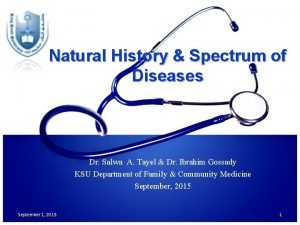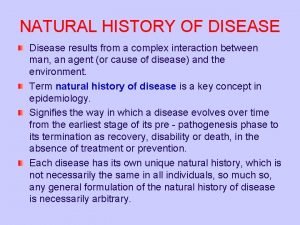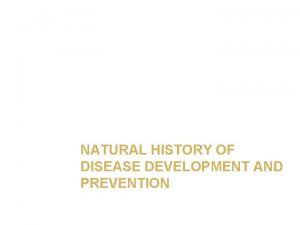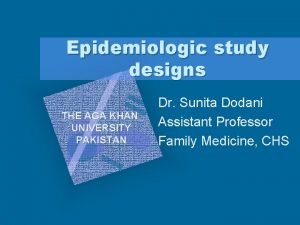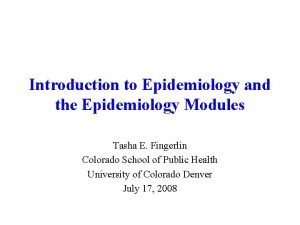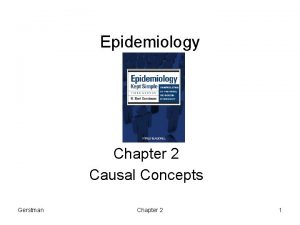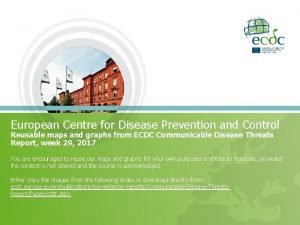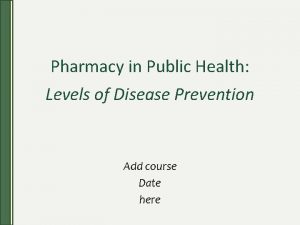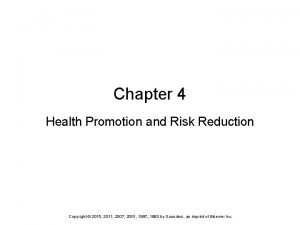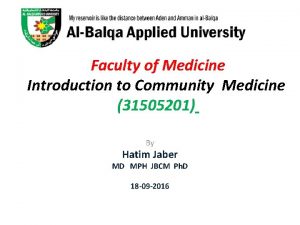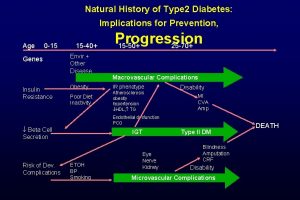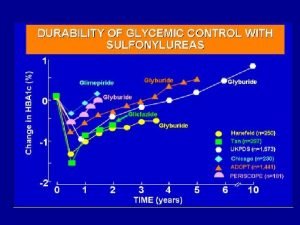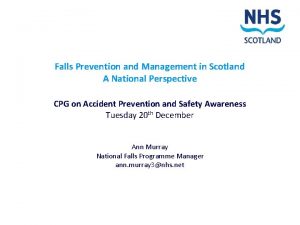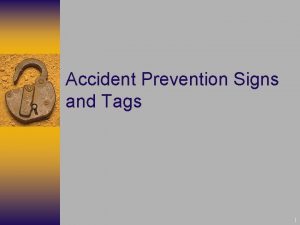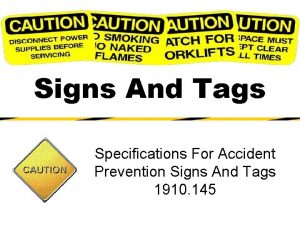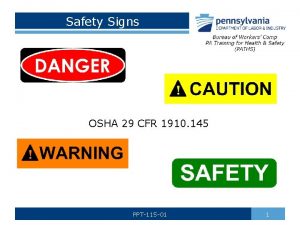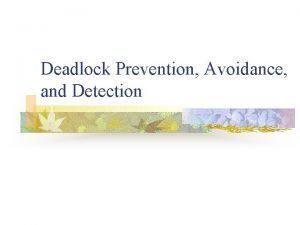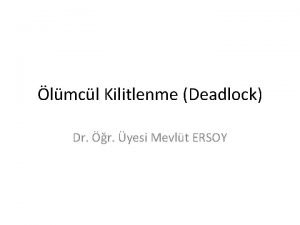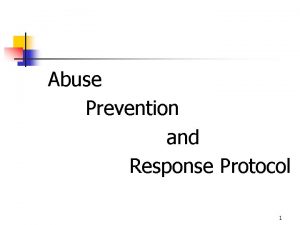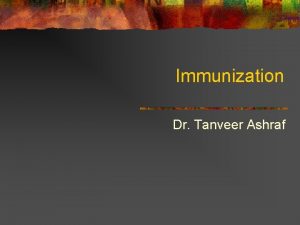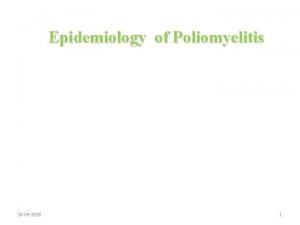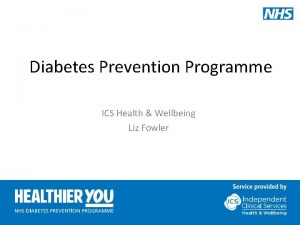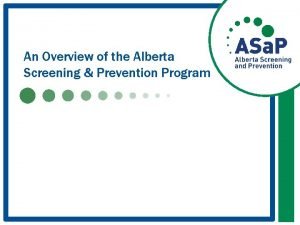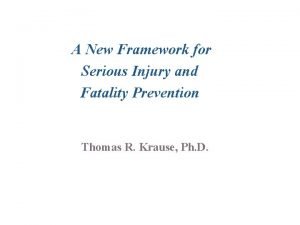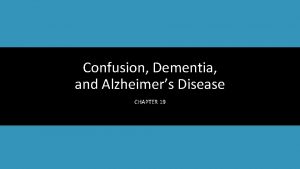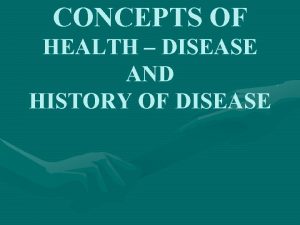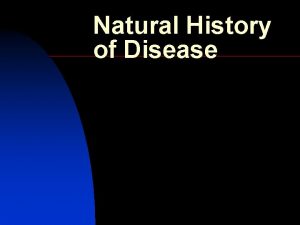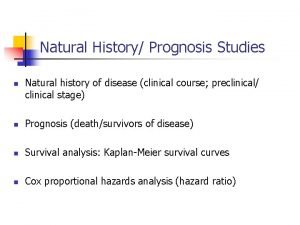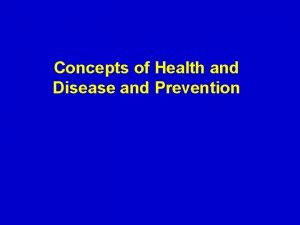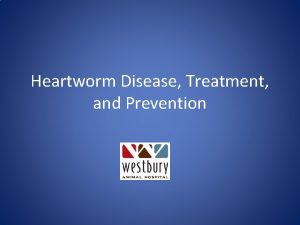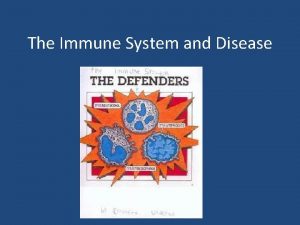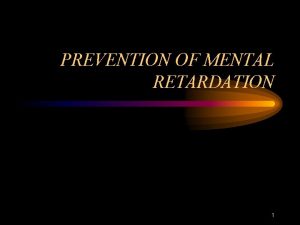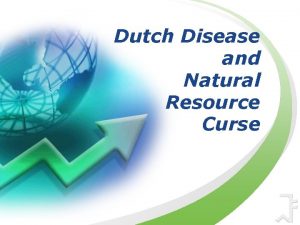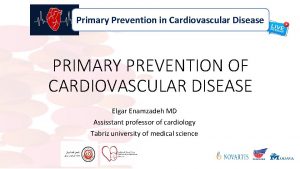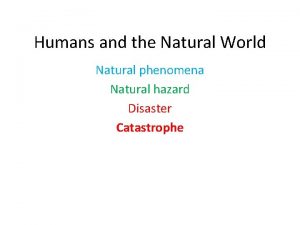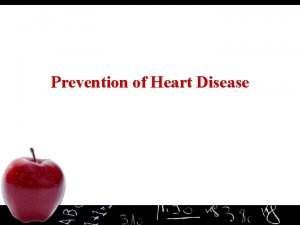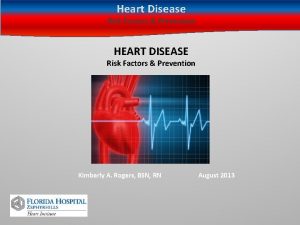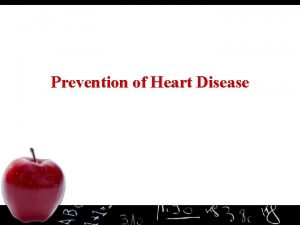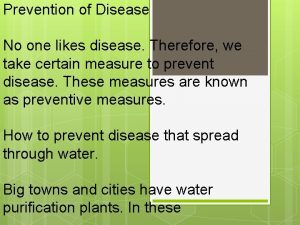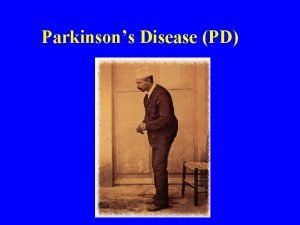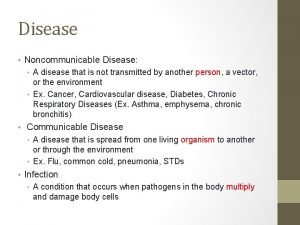Natural History of Disease and Concepts of Prevention


























































- Slides: 58

Natural History of Disease and Concepts of Prevention and Control Dr. Shatha Alduraywish, MBBS; MEpi; Ph. D Assistant Professor, Epidemiologist Department of Family and Community Medicine College of Medicine - King Saud University Email:

Session Objectives To describe theories postulated for the. 1 development of diseases Explain the concepts of iceberg phenomenon. 2 of diseases Understand the relationship between host, . 3 environment and agent in disease causation Define the term prevention. 4 Identify the level of prevention in relation to stage. 5 of disease development Identify the measures applied at each level. 6

Session Overview Theories of Disease Causation. Natural History of Disease Spectrum of Disease Iceberg of Disease Concept of Prevention Modes of Intervention

Diagnostic measures Etiology Risk Factors Therapeutic measures Preventive measures

Theories Of Disease Causation

Germ Theory In the second half of 19 th century Proposed by Robert Koch and Louis Pasteur (discovery of bacteria).

Germ Theory Every human disease is caused by a microbe or germ, which is specific for that disease and one must be able to isolate the microbe from the diseased human being.

Germ Theory One to one relationship between causal agent and disease. Disease agent Man Disease

The Epidemiological Triad

The Epidemiological Triad Example Not everyone exposed to tubercle bacteria develops tuberculosis but the same exposure in an undernourished or immunocompromised person may result in clinical disease and exposure occurs more in overcrowding.

The Epidemiological Triad

Epidemiological Tetrad In addition to HOST, AGENT and ENVIRONMENT, one more factor TIME factor is added. TIME accounts for incubation periods, life expectancy of the host or pathogen, duration of the course of illness.

The “BEINGS” Model of Disease Causation A complex interplay of nine different factors Biological factors innate in a human being, Behavioural factors concerned with individual lifestyles, Environmental factors as physical, chemical and biological aspects of environment, Immunological factors, Nutritional factors, Genetic factors, Social factors, Spiritual factors and Services factors, related to the various aspects of health care services.

The Theory of “Web of Causation” Suggested by Mac. Mohan and Pugh. The various factors (e. g. hypercholesterolemia, smoking, hypertension) are like an interacting web of a spider. Each factor has its own relative importance in causing the final departure from the state of health, as well as interacts with others, modifying the effect of each other.

The Theory of “Web of Causation” Ideally suited in the study of chronic disease, where the agent is often not known and disease is the outcome of interaction of multiple factors. This model of disease causation considers all predisposing factors of any type and their complex interrelationship with each other.

The Theory of “Web of Causation”

Wheel theory As medical knowledge advanced, an additional aspect of interest that came into play is the comparative role of “genetic” and the “environmental” (i. e. extrinsic factors outside the host) factors in causation of disease. The “triad” as well as the “web” theory does not adequately cover up this differential. To explain such relative contribution of genetic and environmental factors, the “wheel” theory has been postulated.

Wheel theory

Wheel theory

Natural History of Disease

Definition Natural history of disease refers to the progress of a disease process in an individual over time, in the absence of intervention. The process begins with exposure to or accumulation of factors capable of causing disease

Without medical intervention, the process ends with: Recover y Disabilit y Death Exposure Recovery Host Disease Disability Death

Why it is important?

Why it is important? It is one of the major elements of descriptive epidemiology. Understanding the progress of disease process and its pathogenetic chain of events is must for the application of preventive measures.

Which Design is the Best The natural history of disease is best established by cohort studies. As these studies are costly, understanding of the natural history of disease is largely based on other epidemiological studies, such as cross-sectional and retrospective studies, undertaken in different population

What the physician sees in the hospital is just an "episode" in the natural history of disease. The epidemiologist, by studying the natural history of disease in the community setting is in a unique position to fill the gaps in the knowledge about the natural history of disease.

Schematic Diagram of The Natural history of disease in a patient Why ? It is framework to understand the pathogenic chain of events for a particular disease, and for the application of preventive measures.


Schematic Diagram of The Natural history of disease in a patient Consists of two phases PREPATHOGENESIS The process in the environment PATHOGENES IS The process in the man

Schematic Diagram of The Natural history of disease in a patient

Pre-pathogenesis phase This refers to the period preliminary to the onset of disease in man. The disease agent has not yet entered man, but the factors which favor its interaction with the human host are already existing in the environment. This situation is frequently referred to as “man exposed to the risk of disease”.

Pathogenesis phase This phase begins with entry of the disease “agent” in the susceptible human host. After the entry, agent multiplies and induces tissue and physiological changes, the disease progresses through the period of incubation and later through the period of early and late pathogenesis. The final outcome of the disease may be recovery, disability or death.

Pathogenesis phase In chronic diseases, the early pathogenesis phase is less dramatic and is also called as pre-symptomatic phase. During pre-symptomatic stage, there is no manifest disease. The pathological changes are essentially below the level of the “clinical horizon”. The clinical stage begins when recognizable signs or symptoms appear. By the time signs and symptoms appear, the disease

Spectrum of Disease and Iceberg Phenomenon

Spectrum of disease It is a graphic representation of variations in the manifestations of disease. At the one end of disease spectrum are sub-clinical infections which are not ordinarily identified, and at the other end are fatal illnesses. In the middle of spectrum lie illnesses ranging in severity from mild to severe. These different manifestations are the result of individuals’ different states of immunity and receptivity.

Iceberg of disease The floating tip Waterline The submerged portion


Spectrum of disease presents challenges to the clinician and to the public health worker. WHY? Because of the clinical spectrum, cases of illness diagnosed by clinicians in the community often represent only the “tip of the iceberg. ” Many additional cases may be too early to diagnose or may remain asymptomatic. For the public health worker, the challenge is that persons with undiagnosed infections may be able to transmit them to others.

Concept of Prevention

Prevention of disease Prevention is the process of intercepting or opposing the “cause” of a disease and thereby the disease process. depends Availability of on: Knowledge. Successful of causation prevention Dynamics of transmission prophylactic or early Identification of risk detection and treatment factors and risk groups measures Organization to apply these measures

Prevention of disease Levels Of Prevention Primordial prevention Primary prevention Secondary prevention Tertiary prevention

Primordial prevention It is the prevention of the emergence or development of risk factors in population groups in which they HAVE NOT yet appeared. For example, many adult health problems (e. g. , obesity and hypertension) have their early origin in childhood, so efforts are directed towards encouraging children to adopt healthy lifestyles ( e. g, physical exercise, healthy dietary habits etc. ) The main intervention in primordial prevention is through individual and mass education.

Primary Prevention It can be defined as “ action taken prior to the onset of disease, which removes the possibility that a disease will ever occur. It signifies intervention in the pre- pathogenesis phase of a disease.


Primary Prevention Two types of strategies Population( mass ) strategy High risk strategy

Primary Prevention Population strategy directed at whole population irrespective of the individual risk levels. directed towards socio-economic, behavioral and lifestyle changes. High risk strategy Includes identification of “High risk groups” in the population and bring preventive care to these risk group. e. g. , People having the family history of Hypertension, allergic disease, Diabetes.

Primary Prevention

Secondary prevention Defined as “action which stop the progress of a disease at its initial stage and prevents complications”. It is applied in the early pathogenesis stage of disease. It reduce the prevalence of the disease by shortening its duration. It may also protect others in the community from acquiring the infection and thus provide, at once, secondary prevention for the infected individuals and primary prevention for their potential contacts.


Secondary prevention The specific interventions used is : Early diagnosis and treatment. Early detection of health impairment is defined as “ the detection of disturbances of homoeostatic and compensatory mechanism while biochemical, morphological and functional changes are still reversible. e. g. , screening for disease for breast cancer (using mammography) and cervical cancer (using pap smear). Medical examinations of school children, of

Tertiary prevention These include all measures undertaken when the disease has become clinically manifest or advanced, with a view to prevent or delay death, reduce or limit the impairments and disabilities, minimize suffering and promote the subject’s adjustment to incurable conditions. Tertiary prevention has two types of approaches disability limitation rehabilitation.


Tertiary prevention Disability Limitation These include all measures to prevent the occurrence of further complications, impairments, disabilities and handicaps or even death. Examples Complete rest, morphine, oxygen and streptokinase is given to a patient of Acute MI, to prevent death or complications like arrhythmias / CHF. Application of plaster cast to a patient who has suffered Colle’s fracture, is done to prevent complications and further disability like mal-union or non-union.

Tertiary prevention

Tertiary prevention Rehabilitation It is defined as the combined and coordinated use of medical, social, educational and occupational measures for training and retraining the individual to the highest possible level of functional ability.

Tertiary prevention Examples of Rehabilitation Establishing schools for blinds Provision of aids for the handicapped Reconstructive surgery in leprosy Muscle re-education and graded exercises in neurological disorders

Levels of prevention

 Primary prevention secondary prevention tertiary prevention
Primary prevention secondary prevention tertiary prevention Natural history and spectrum of disease
Natural history and spectrum of disease Natural history of disease adalah
Natural history of disease adalah Prepathogenesis phase
Prepathogenesis phase Explain natural history of disease
Explain natural history of disease Natural history of disease is best studied by
Natural history of disease is best studied by Tasha introduction
Tasha introduction Spectrum of disease
Spectrum of disease Puncture resistant container
Puncture resistant container Chapter 26 infectious disease prevention and control
Chapter 26 infectious disease prevention and control Chapter 19 disease transmission and infection prevention
Chapter 19 disease transmission and infection prevention European centre for disease prevention and control
European centre for disease prevention and control Health promotion and levels of disease prevention
Health promotion and levels of disease prevention Chapter 19 disease transmission and infection prevention
Chapter 19 disease transmission and infection prevention Health promotion and levels of disease prevention
Health promotion and levels of disease prevention Bharathi viswanathan
Bharathi viswanathan Concept of health
Concept of health Introduction to community medicine
Introduction to community medicine Natural and artificial concepts
Natural and artificial concepts Natural capital
Natural capital Ib historical concepts
Ib historical concepts Natural hazards vs natural disasters
Natural hazards vs natural disasters The plastic pink flamingo: a natural history
The plastic pink flamingo: a natural history National museum british
National museum british American musuem of natural history
American musuem of natural history Natural history of type 2 diabetes
Natural history of type 2 diabetes Natural history of type 2 diabetes
Natural history of type 2 diabetes Spill prevention control and countermeasure plan template
Spill prevention control and countermeasure plan template Precca
Precca Dfpc jprs
Dfpc jprs Injuries first aid
Injuries first aid National and local guidance on falls prevention
National and local guidance on falls prevention Accident prevention signs and tags
Accident prevention signs and tags Accident prevention signs
Accident prevention signs 29cfr1910 120
29cfr1910 120 Osha needlestick protocol
Osha needlestick protocol Menurut leavel and clark
Menurut leavel and clark Deadlock prevention or avoidance
Deadlock prevention or avoidance Policy on harassment prevention and resolution
Policy on harassment prevention and resolution Starvation deadlock
Starvation deadlock What is the subpart for fire protection and prevention
What is the subpart for fire protection and prevention Professional nursing practice concepts and perspectives
Professional nursing practice concepts and perspectives School crisis prevention and intervention
School crisis prevention and intervention What is the general industry subpart for fire protection
What is the general industry subpart for fire protection Workplace fatality prevention
Workplace fatality prevention Starvation vs deadlock
Starvation vs deadlock Chapter 16 infection control and standard precautions
Chapter 16 infection control and standard precautions Abuse prevention and response protocol
Abuse prevention and response protocol Loss prevention and security in hotels
Loss prevention and security in hotels Prevention and control of poliomyelitis
Prevention and control of poliomyelitis Poliomyelitis slideshare
Poliomyelitis slideshare Diabetes wellness programme
Diabetes wellness programme Alberta screening and prevention program
Alberta screening and prevention program Serious injury and fatality prevention
Serious injury and fatality prevention History also history physical
History also history physical Four model approach
Four model approach Describe data and process modeling concepts and tools
Describe data and process modeling concepts and tools Chapter 35 immune system and disease
Chapter 35 immune system and disease Chapter 19 confusion dementia and alzheimer's disease
Chapter 19 confusion dementia and alzheimer's disease

